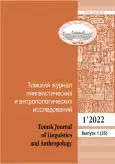В ситуации глобального культурного нивелирования и повсеместных межэтнических конфликтов возникают задачи, связанные с формированием и сохранением национального самосознания как целого народа, так и отдельного человека. Особенно актуально рассмотрение данной проблемы в лингвокультурологическом поле гуманитарных исследований. Между тем, наименование народа, народности — один из факторов этнической идентичности человека. Этнонимы содержат «генетический код», позволяют обозначить определяющие национальные признаки, отличить «своих» от «чужих». Этноним сам по себе очень информативен, так как даёт возможность изучить пути исторической миграции этнического сообщества, его взаимодействие с культурой и языком народа-прародителя, культурные контакты с другими народами, указывает на род занятий, конфессиональную принадлежность представителей сообщества. Цель статьи — проанализировать формирование, функционирование и словообразовательный потенциал этнонимов бухарцы, сарты, называющих этносоциальную группу выходцев из Средней Азии, которые переселялись в Сибирь в конце XIV–XVIII веках и принимали активное участие в освоении этой большой и богатой на возможности территории. Пройдя сложный путь исторического развития, сибирские бухарцы со временем ассимилировались с местными народами, внеся существенный вклад в становление культуры тюркского населения Сибири и став значимым этническим компонентом в структуре этноса сибирских татар. Материалом для исследования послужили памятники деловой письменности XIX — начала XX века, включая метрические записи, документы переписи населения, служебную переписку, прошения и челобитные, документы по податям и сборам, записи по юридическим процедурам, указы, протоколы, рапорты, отчёты и прочее, в которых нашли отражение факты экономического, политического и культурного развития общины сибирских бухарцев. Источники представляют собой как официальные документы, имевшие обращение в делопроизводстве столичных министерств и департаментов, региональных приказов и отделов, так и рукописные записи, сделанные при мечетях на старотатарском языке арабской графикой. В качестве иллюстративного материала представлены записи полевых экспедиций авторов в сельские населенные пункты (2014–2021 гг.).Анализ содержательной стороны документов, с одной стороны, позволяет проследить пути формирования самоидентичности отдельной этнической общности, с другой — увидеть региональную специфику и определить языковой потенциал терминов-самонаименований. Этнонимы становятся базой для появления дериватов-новообразований: прозвищ, имен, патронимов, фамилий, топонимов.Для анализа ономастикона, представленного в статье, использовался описательный метод с применением его основных приемов: наблюдения, обобщения и классификации материала. Для семантической реконструкции был использован метод этимологического анализа с учетом фонетического и словообразовательного аспектов. Анализ формирования и становления этнонимов в регионе представляется актуальным, поскольку в научный оборот вводятся новые антропонимические данные. Изучение этнонимов, именующих этносоциальную группу сибирских бухарцев, позволит дать более полную историко-культурную характеристику одному из важных этнических сообществ региона и расширит научные представления о культуре и истории Западной Сибири в целом.
 9-18
9-18


 19-32
19-32


 33-45
33-45


 46-55
46-55


 56-77
56-77


 78-91
78-91


 92-105
92-105


 106-114
106-114


 115-123
115-123


 124-134
124-134


 135-145
135-145


 146-156
146-156


 157-171
157-171


 172-186
172-186












